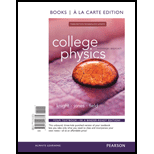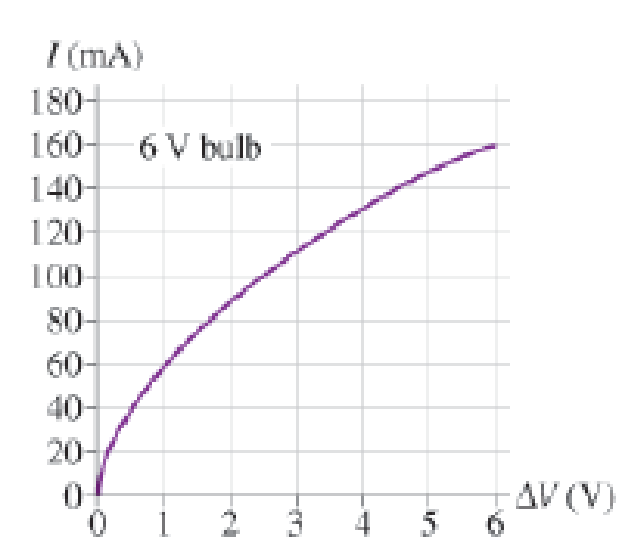
MCAT-Style Passage Problems
Lightbulb Failure
You’ve probably observed that the most common time for an incandescent lightbulb to fail is the moment when it is turned on. Let’s look at the properties of the bulb’s filament to see why this happens.
The current in the tungsten filament of a lightbulb heats the filament until it glows. The filament is so hot that some of the atoms on its surface fly off and end up sticking on a cooler part of the bulb. Thus the filament gets progressively thinner as the bulb ages. There will certainly be one spot on the filament that is a bit thinner than elsewhere. This thin segment will have a higher resistance than the surrounding filament. More power will be dissipated at this spot, so it won’t only be a thin spot, it also will be a hot spot.
Now, let’s look at the resistance of the filament. The graph in Figure P22.70 shows data for the current in a lightbulb as a function of the potential difference across it. The graph is not linear, so the filament is not an ohmic material with a constant resistance, However we can define the resistance at any particular potential difference ∆V to be R = ∆V/I. This ratio, and hence the resistance, increases with ∆V and thus with temperature.
Figure P22. 70

When the bulb is turned on, the filament is cold and its resistance is much lower than during normal, high-temperature operation. The low resistance causes a surge of higher-than-normal current lasting a fraction of a second until the filament heats up. Because power dissipation is I2R, the power dissipated during this first fraction of a second is much larger than the bulb’s rated power. This current surge concentrates the power dissipation at the high-resistance thin spot, perhaps melting it and breaking the filament.
71. As the bulb ages, the resistance of the filament
A. Increases.
B. Decreases.
C. Stays the same.
Want to see the full answer?
Check out a sample textbook solution
Chapter 22 Solutions
College Physics: A Strategic Approach Technology Update, Books a la Carte Edition; Modified Mastering Physics with Pearson eText -- ValuePack Access ... Physics: A Strategic Approach (3rd Edition)
Additional Science Textbook Solutions
Lecture- Tutorials for Introductory Astronomy
College Physics
University Physics with Modern Physics (14th Edition)
University Physics Volume 1
Conceptual Physics (12th Edition)
An Introduction to Thermal Physics
- Taking R = 1.00 kΩ and ε = 250 V in Figure P18.21, determine the direction and magnitude of the current in the horizontal wire between a and e.arrow_forwardConsider a resistor made from a hollow cylinder of carbon as shown below. The inner radius of the cylinder is Ri = 0.20 mm and the outer radius is R0 = 0.30 mm . The length of the resistor is L = 0.90 mm . The resistivity of the carbon is ρ = 3.5 × 10−5 Ω · m . (a) Prove that the resistance perpendicular from the axis is R = ρ 2πLln ( R0 Ri). (b) What is the resistance?arrow_forwardIn your new job at an engineering company, your supervisor asks you to fabricate a resistor that has a resistance of R = 0.100 Ω and no change in resistance with temperature. She suggests making the resistor from lengths of cylindrical carbon and Nichrome wires of equal radius, placed end-toend. She wants the combination to fit into a machine that allows for a radius of the resistor to be r = 1.50 mm. What are the lengths of the two segments of the resistor?arrow_forward
- Consider the circuit shown, where V1V1 = 1.8 V, V2V2 = 2.40 V, R1R1 = 2.2 kΩ, R2R2 = 2.5 kΩ, and R3R3 = 1.5 kΩ. 1)What is the current through resistor R1R1 in milliamperes? 2)What is the current through resistor R2R2 in milliamperes? 3)What is the power dissipated in resistor R3R3 in milliwatts? 4)What is the total power in milliwatts delivered to the circuit by the two batteries?arrow_forwardWire C and wire D are made from different materials and have length LC = LD = 3.1 m. The resistivity and diameter of wire C are 3.3 × 10-6 Ω·m and 1.03 mm, and those of wire D are 1.2 × 10-6 Ω·m and 0.72 mm. The wires are joined as shown in the figure and a current of 2.6 A is set up in them. What is the electric potential difference between (a) points 1 and 2 and (b) points 2 and 3? What is the rate at which energy is dissipated between (c) points 1 and 2 and (d) points 2 and 3?arrow_forwardAn aluminum rod with a square cross-section is 2.6 m long and 5.3 mm on edge. (a) What is the resistance between its ends? (b) What must be the diameter of a cylindrical copper rod of length 2.6 m if its resistance is to be the same as that of the aluminum rod? The resistivity of aluminum is 2.75 × 10-8 Ω·m and the resistivity of copper is 1.69 × 10-8 Ω·m.arrow_forward
- A typical lightning bolt may last for 0.200 s and transfer 1.00 x1020 electrons. Calculate the average current in the lightningbolt.arrow_forwardA 4.0- resistor has a current of 3.0 A in it for 5.0 min. How many electrons pass through the resistor during this time interval?arrow_forwardThe circuit shown in the figure consists of ideal batteries ?1 =20V and ?2 =20V, resistors ? =600Ω, ?1 =600Ω and initially uncharged two capacitors with capacitances ?1 = ?2 =10mF. The circuit is completed when switch S is closed at time t=0. Use the loop rules and the relationship between the charging current i and the charge q of the capacitors a) to obtain a differential equation that allows you to determine how the charge q of thecapacitors varies with time.b) What are the capacitor charges if the switch S is closed for a long time?c) Find the current through the battery ?1 at time t = 3 s after the switch closes.arrow_forward
- Kiting during a storm. The legend that Benjamin Franklin flew a kite as a storm approached is only a legend — he was neither stupid nor suicidal. Suppose a kite string of radius 2.10 mm extends directly upward by 0.802 km and is coated with a 0.520 mm layer of water having resistivity 155 Ω·m. If the potential difference between the two ends of the string is 176 MV, what is the current through the water layer? The danger is not this current but the chance that the string draws a lightning strike, which can have a current as large as 500 000 A (way beyond just being lethal).arrow_forwardYou’ve probably observed that the most common time for an incandescent lightbulb to fail is the moment when it is turned on. Let’s look at the properties of the bulb’s filament to see why this happens.The current in the tungsten filament of a lightbulb heats the filament until it glows. The filament is so hot that some of the atoms on its surface fly off and end up sticking on a cooler part of the bulb. Thus the filament gets progressively thinner as the bulb ages. There will certainly be one spot on the filament that is a bit thinner than elsewhere. This thin segment will have a higher resistance than the surrounding filament. More power will be dissipated at this spot, so it won’t only be a thin spot, it also will be a hot spot.Now, let’s look at the resistance of the filament. The graph in Figure P22.70 shows data for the current in a lightbulb as a function of the potential difference across it. The graph is not linear, so the filament is not an ohmic material with a constant…arrow_forwardYou’ve probably observed that the most common time for an incandescent lightbulb to fail is the moment when it is turned on. Let’s look at the properties of the bulb’s filament to see why this happens.The current in the tungsten filament of a lightbulb heats the filament until it glows. The filament is so hot that some of the atoms on its surface fly off and end up sticking on a cooler part of the bulb. Thus the filament gets progressively thinner as the bulb ages. There will certainly be one spot on the filament that is a bit thinner than elsewhere. This thin segment will have a higher resistance than the surrounding filament. More power will be dissipated at this spot, so it won’t only be a thin spot, it also will be a hot spot.Now, let’s look at the resistance of the filament. The graph in Figure P22.70 shows data for the current in a lightbulb as a function of the potential difference across it. The graph is not linear, so the filament is not an ohmic material with a constant…arrow_forward
 Principles of Physics: A Calculus-Based TextPhysicsISBN:9781133104261Author:Raymond A. Serway, John W. JewettPublisher:Cengage Learning
Principles of Physics: A Calculus-Based TextPhysicsISBN:9781133104261Author:Raymond A. Serway, John W. JewettPublisher:Cengage Learning Physics for Scientists and Engineers: Foundations...PhysicsISBN:9781133939146Author:Katz, Debora M.Publisher:Cengage Learning
Physics for Scientists and Engineers: Foundations...PhysicsISBN:9781133939146Author:Katz, Debora M.Publisher:Cengage Learning
 Physics for Scientists and EngineersPhysicsISBN:9781337553278Author:Raymond A. Serway, John W. JewettPublisher:Cengage Learning
Physics for Scientists and EngineersPhysicsISBN:9781337553278Author:Raymond A. Serway, John W. JewettPublisher:Cengage Learning Physics for Scientists and Engineers with Modern ...PhysicsISBN:9781337553292Author:Raymond A. Serway, John W. JewettPublisher:Cengage Learning
Physics for Scientists and Engineers with Modern ...PhysicsISBN:9781337553292Author:Raymond A. Serway, John W. JewettPublisher:Cengage Learning




